| |
GNATCATCHERS Polioptilidae |
- 20 species in the Western Hemisphere
- DR personal total: 11 species (55%), 6 photo'd
|
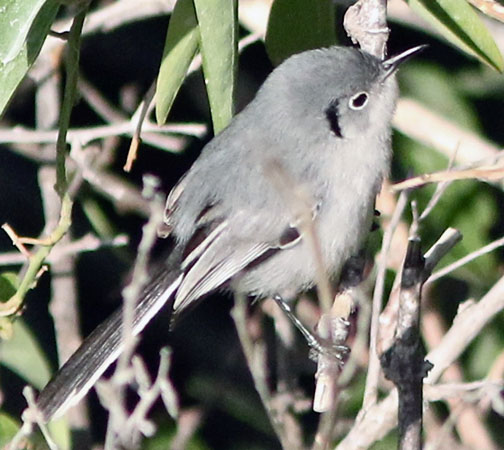 The Polioptilidae is a homogeneous, easily recognized family of small New World passerines. Most of the family are called gnatcatchers, but four gnatwrens are also included. Sixteen of 20 species are in the genus Polioptila, assuming one accepts recently described or elevated species, such as Yucatan Gnatcatcher P. albiventris of northern Yucatan Peninsula (split on genetic grounds) and Iquitos Gnatcatcher P. clementsi, described on vocal and plumage grounds, and apparently limited to a few white-sands patches near Iquitos in northeastern Peru. Of the twenty gnatcatchers, three are primarily North American, three are primarily from Mexico to Central America, one (Tropical Gnatcatcher P. plumbea) is widespread in the Neotropics from Mexico to northern South America, eight are generally South American, and one is endemic to the Caribbean: Cuban Gnatcatcher (left and below). The Polioptilidae is a homogeneous, easily recognized family of small New World passerines. Most of the family are called gnatcatchers, but four gnatwrens are also included. Sixteen of 20 species are in the genus Polioptila, assuming one accepts recently described or elevated species, such as Yucatan Gnatcatcher P. albiventris of northern Yucatan Peninsula (split on genetic grounds) and Iquitos Gnatcatcher P. clementsi, described on vocal and plumage grounds, and apparently limited to a few white-sands patches near Iquitos in northeastern Peru. Of the twenty gnatcatchers, three are primarily North American, three are primarily from Mexico to Central America, one (Tropical Gnatcatcher P. plumbea) is widespread in the Neotropics from Mexico to northern South America, eight are generally South American, and one is endemic to the Caribbean: Cuban Gnatcatcher (left and below).
Gnatcatchers are nervous, energetic, active small birds, given to twitching their longish tails (as the Cuban Gnatcatcher below is doing). All are essentially pale gray above, whitish below (with varying degrees of duskiness), and have complex tail patterns of black and white. Males of 7 species are black-capped to varying degrees. The male Cuban Gnatcatcher is distinctive by having a black outline to the back of the face. Females generally lack the black facial patterns or caps seen on males of their species. |
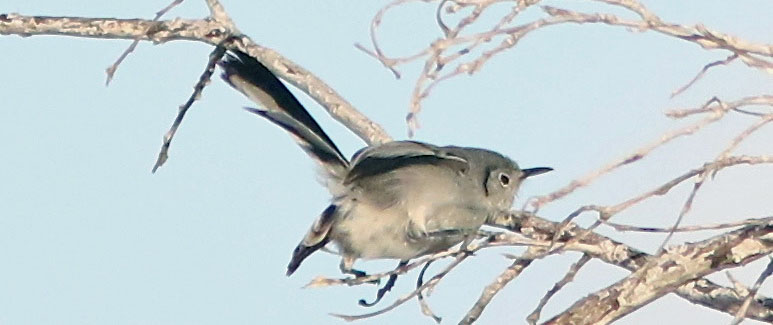 |
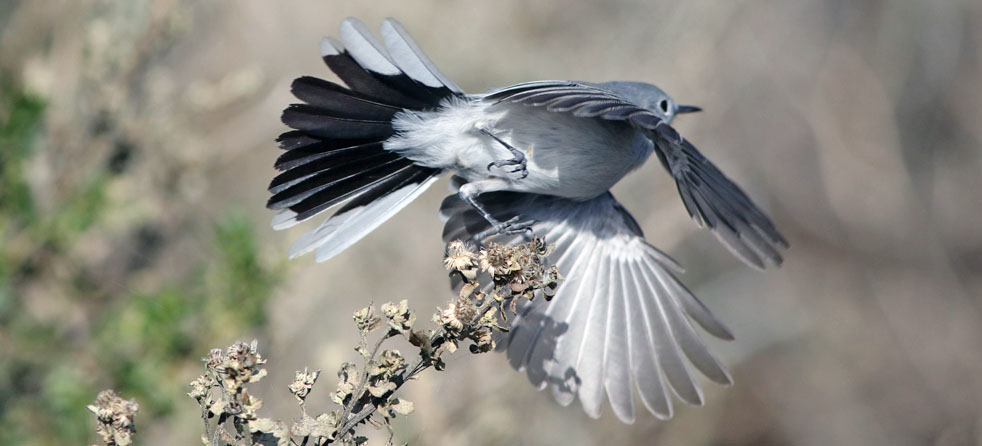 |
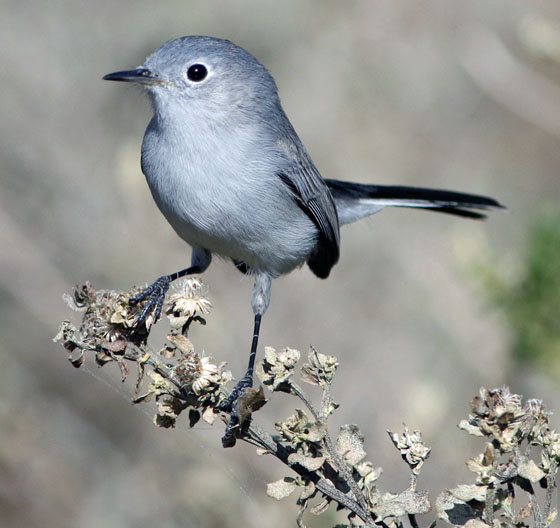 The widespread species in North America is Blue-gray Gnatcatcher (above, left and right) which looks gray-and-white all year with a prominent white eyering (right). There is extensive white in the outer rectrices (above). Spring males in alternate plumage have a short black eyebrow (just below). Their scolding notes is characteristic of brushy habitats in the West, but singing males have a delightful and melodic song. There is also a population in eastern United States. Most of these U.S. populations migrate south or to the coast in winter, and some migrate as far as Honduras or Cuba (Blue-grays must to carefully separated from the limited resident coastal population of Cuban Gnatcatcher in winter in Cuba). In the southern U.S., there are resident population along the Gulf coast, and widespread residents in northern Mexico. The widespread species in North America is Blue-gray Gnatcatcher (above, left and right) which looks gray-and-white all year with a prominent white eyering (right). There is extensive white in the outer rectrices (above). Spring males in alternate plumage have a short black eyebrow (just below). Their scolding notes is characteristic of brushy habitats in the West, but singing males have a delightful and melodic song. There is also a population in eastern United States. Most of these U.S. populations migrate south or to the coast in winter, and some migrate as far as Honduras or Cuba (Blue-grays must to carefully separated from the limited resident coastal population of Cuban Gnatcatcher in winter in Cuba). In the southern U.S., there are resident population along the Gulf coast, and widespread residents in northern Mexico.
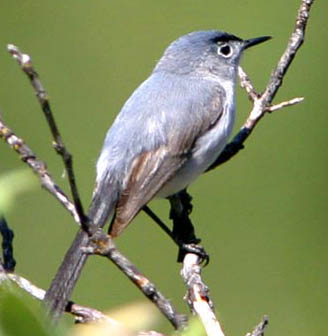 |
 |
| The remaining three North American gnatcatchers have black-capped males. California Gnatcatcher (above) is the darkest species, and has a very limited range. It can be difficult to see in thick undergrowth, or brush, or coastal chaparral, but it is not a shy bird. This photo captures it within that habitat. California Gnatcatcher was initially described as a new species in 1888, but was lumped with Black-tailed in 1926. It was not restored to full species level until 1993. The biochemical evidence is that it became isolated in Baja California during the Pleistocene but spread northward after the last Ice Age. Its DNA is divergent from Black-tailed Gnatcatcher by about 4% (Zink & Blackwell 1998). Today it is still reasonably common in Baja California, Mexico, but within the United States it is restricted to maritime chaparral in southern California. That habitat has undergone tremendous development pressure and is today very fragmented. Only small numbers of California Gnatcatcher remain in California, where it is listed as Threatened under Endangered Species laws (Atwood & Lerman 2006). |
 North American species are sexually dimorphic. Males have black caps but females do not. This shot (left) shows a female Black-tailed Gnatcatcher on a nest in a mesquite bush in Arizona. Nests are a deep cup woven in the fork of branches. It is held together by spider webs and lined with feathers. Both sexes help in nest building and often reuse materials from old nests. The finished product provides good camouflage. Male Black-tailed Gnatcatchers also share in incubating the eggs and feeding the young. In hot places like Arizona, another task is shading the young from the sun by perching at the nest edge with outstretched wings (Atwood & Lerman 2006). North American species are sexually dimorphic. Males have black caps but females do not. This shot (left) shows a female Black-tailed Gnatcatcher on a nest in a mesquite bush in Arizona. Nests are a deep cup woven in the fork of branches. It is held together by spider webs and lined with feathers. Both sexes help in nest building and often reuse materials from old nests. The finished product provides good camouflage. Male Black-tailed Gnatcatchers also share in incubating the eggs and feeding the young. In hot places like Arizona, another task is shading the young from the sun by perching at the nest edge with outstretched wings (Atwood & Lerman 2006).
Nearly all species in this family are resident. Only Blue-gray Gnatcatcher undergoes any regular migration. However, the edges of breeding ranges can expand and contract, and these developments have brought an occasional Black-capped Gnatcatcher (below, both shots) into Arizona. This otherwise Mexican species nests some years in southeast Arizona (as did this male in Chino Canyon in 1983, below left) but in many years none are found within the U.S. Then a few years will pass and another pair or lone bird will be in southeast Arizona again. Within the sexually dimorphic species, identification can be problematic with keys points being bill size, undertail pattern, and vocalizations. Black-tailed Gnatcatcher is named for the significant amount of black on the underside of the tail. Black-capped Gnatcatcher, a quite similar bird, differs primarily by its slightly longer bill and because its undertail has a lot more white in it, more similar to Blue-gray. The female Black-capped (below right) is showing the underside of its tail well.
I confess that the experiences in chasing these two different vagrant pairs of Black-capped Gnatcatchers were quite different. In 1983, friends and I drove a rental sedan over a heavily-rutted road, with washed-out stream crossings, to get to Chino Canyon, where we camped. It then took quite an effort working through the dense, thorny hackberry patches to see the male. In 2015, a pair were in lower Madera Canyon, easily accessed by a paved road, and the female was found along a paved nature trail, accessible to wheelchairs. The times, they are a-changing. |
|
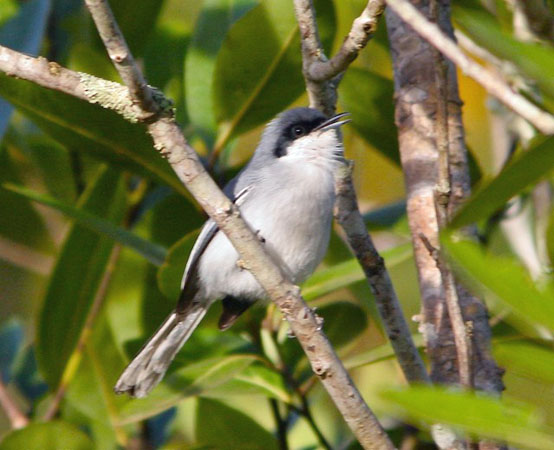 With recent splits, more than half the gnatcatchers are South American species; the family evolved in South America (Smith et al. 2018). Masked Gnatcatcher (right) has a broad distribution south and east of the Amazon Basin, preferring a variety of dry forest types. It has little geographic overlap with other species of Polioptila. With recent splits, more than half the gnatcatchers are South American species; the family evolved in South America (Smith et al. 2018). Masked Gnatcatcher (right) has a broad distribution south and east of the Amazon Basin, preferring a variety of dry forest types. It has little geographic overlap with other species of Polioptila.
The species-level taxonomy of South American gnatcatchers has been the subject of debate in recent years. Here's a snippet of taxonomic notes from the South American Checklist Committee:
Whitney and Alvarez (2005) provided evidence that P. guianensis should be treated as three separate species, with the subspecies paraensis and facilis treated as species-level taxa. Atwood and Lerman (2006) followed this treatment. [SACC proposal for recognition of P. facilis and P. paraensis did not pass, but SACC proposal passed for recognition of P. clementsi]. Whittaker et al. (2013) described a new species in the complex from southwestern Amazonian Brazil, Polioptila attenboroughi, and presented evidence that paraensis and facilis should also be ranked as separate species. [SACC proposal to recognize these as species did not pass]. Smith et al. (2018) generally corroborated all previously proposed species-level elevations and novel species descriptions (Whitney et al. 2005, Whittaker et al. 2013) in the Polioptila guianensis complex, which had been based on analyses of combined vocal and morphological data sets [SACC proposal passed to recognize facilis, paraensis, and attenboroughi as species].
In short, although it took over a dozen years of debate, with various proposals failing and eventually wining, to determine that what was once thought to be Guianan Gnatcatcher P. guianensis should be split into four species: Guianan, Rio Negros P. facilis, Klage's (Para) P. paraensis, and Iquitos P. clementsi. A bit later, Inambari Gnatcatcher P. attenboroughi was discovered and recognized by the SACC. Not all global checklists are fully on-board with these changes, as in some instances vocal differences are subtle and whether each is a species under the Biological Species Concept has yet to be researched and proven. |
Genetic evidence revealed that gnatcatchers are most closely related to wrens, another (mostly) New World family (Barker et al. 2002, 2004, Alström et al. 2006). This finding resolves what has been a tortured taxonomic history. For many years they were thought to be related to Old World Warbler [Sylviidae], and for a while they were thought to be closely related to Kinglets [Regulidae]. In the more distant past, claims of relationships to Old World Flycatchers [Muscicapidae] or New World Warblers [Parulidae] were made. In the end, it makes logical sense that gnatcatchers and gnatwrens are most closely related to wrens.
This particularly applies to the final two genera in the family [Microbates and Ramphocaenus] which hold four species of gnatwrens. The small size, long bills, and short tails of gnatwrens do make them more wren-like than other members of the Polioptilidae. Tropical gnatcatchers and gnatwrens often forage with mixed feeding flocks, both in scrub and understory, and (for some species) in the canopy. Long-billed Gnatwren (below in a fine shot by Arther Grosset) hunts in vine tangles at middle or upper levels, where it is quite active, cocking its tail or flipping side to side.
|
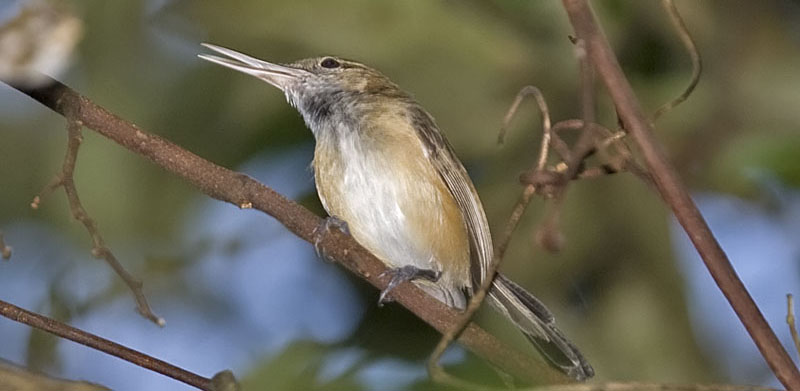 |
| |
Photos: The two photos of Cuban Gnatcatcher Polioptila lembeyei were from Faro Paredón Grande, Cuba, on 11 Feb 2017. The upper two photos of Blue-gray Gnatcatcher Polioptila caerulea were taken at Pt. Lobos SR, California, USA, on 9 Dec 2017; the breeding-plumaged male was in montane chaparral in Trinity County, California, on 19 June 2006. The California Gnatcatcher Polioptila californica was at San Elijo Lagoon, San Diego County, California, on 19 Apr 2006. The nest with female Black-tailed Gnatcatcher Polioptila melanura was in Chino Canyon, Arizona, on 2 July 1983. The male Black-capped Gnatcatcher Polioptila nigriceps was in Chino Canyon, Arizona, on 2 July 1983; the female was in Madera Canyon, Arizona, on 2 May 2015. The Masked Gnatcatcher Polioptila dumicola was at Emas NP, Brazil, on 27 July 2010. Arthur Grosset took the photo of Long-billed Gnatwren Ramphocaenus melanurus was at Tamandaré, Pemambuco, Brazil, in Oct 2008.
All photos © Don Roberson, except the Long-billed Gnatcatcher © Arthur Grosset, as credited; all rights reserved. Arther Grosset's website brings together an impressive collection of bird photos, many from the Neotropics.
Bibliographic note: There is no "family book" covering the Gnatcatchers but the summary by Atwood & Lerman (2006) is excellent, and contains many striking photos.
Literature cited:
Alström P., P.G.P. Ericson, U. Olsson, and P. Sundberg. 2006. Phylogeny and classification of the avian superfamily Sylvioidea. Molec. Phylog. Evol. 38: 381–397.
Atwood, J.L., and S.B. Lerman. 2006. Family Polioptilidae (Gnatcatchers), pp. 350–377, in Handbook of the Birds of the World (del Hoyo, J., Elliott, A., and Christie, D.A., eds). Vol. 11. Lynx Edicions, Barcelona, Spain.
Barker, F.K., G.F. Barrowclough, and J.G. Groth. 2002. A phylogenetic hypothesis for passerine birds: taxonomic and biogeographic implications of an analysis of nuclear DNA sequence data. Proc. Roy. Soc. Lond. B. 269: 295–305
Barker, F.K., A. Cibois, P. Schikler, J. Feinstein, and J. Cracraft. 2004. Phylogeny and diversification of the largest avian radiation. Proc. Nat. Acad. Sci. 101: 11040–11045.
Smith, B.T., R.W. Bryson, Jr., W. Mauck, and J.A. Chaves. 2018. Species delimitation and biogeography of the gnatcatchers and gnatwrens (Aves: Polioptilidae). Molec. Phylog. Evol. 126: 45–57.
Whittaker, A., A. Aleixo, B.M. Whitney, B.T. Smith, and J. Klicka. 2013. "A distinctive new species of gnatcatcher in the Polioptila guianensis complex (Aves: Polioptilidae) from western Amazonian Brazil," pp. 301–305 in Handbook of the Birds of the World. Special Volume: New Species and Global Index. Lynx Edicions, Barcelona, Spain.
Whitney, B.M., and J.A. Alvarez. 2005. A new species of gnatcatcher from white-sand forests of northern Amazonian Peru with revision of the Polioptila guianensis complex. Wilson Bull. 117: 113–127.
Zink, R.M., and R. C. Blackwell. 1998. Molecular systematics and biogeography of aridland gnatcatchers (genus Polioptila) and evidence supporting species status of the California Gnatcatcher (Polioptila californica). Molec. Phylog. Evol. 9: 26–32.
|
|
|





 The Polioptilidae is a homogeneous, easily recognized family of small New World passerines. Most of the family are called gnatcatchers, but four gnatwrens are also included. Sixteen of 20 species are in the genus Polioptila, assuming one accepts recently described or elevated species, such as Yucatan Gnatcatcher P. albiventris of northern Yucatan Peninsula (split on genetic grounds) and Iquitos Gnatcatcher P. clementsi, described on vocal and plumage grounds, and apparently limited to a few white-sands patches near Iquitos in northeastern Peru. Of the twenty gnatcatchers, three are primarily North American, three are primarily from Mexico to Central America, one (Tropical Gnatcatcher P. plumbea) is widespread in the Neotropics from Mexico to northern South America, eight are generally South American, and one is endemic to the Caribbean: Cuban Gnatcatcher (left and below).
The Polioptilidae is a homogeneous, easily recognized family of small New World passerines. Most of the family are called gnatcatchers, but four gnatwrens are also included. Sixteen of 20 species are in the genus Polioptila, assuming one accepts recently described or elevated species, such as Yucatan Gnatcatcher P. albiventris of northern Yucatan Peninsula (split on genetic grounds) and Iquitos Gnatcatcher P. clementsi, described on vocal and plumage grounds, and apparently limited to a few white-sands patches near Iquitos in northeastern Peru. Of the twenty gnatcatchers, three are primarily North American, three are primarily from Mexico to Central America, one (Tropical Gnatcatcher P. plumbea) is widespread in the Neotropics from Mexico to northern South America, eight are generally South American, and one is endemic to the Caribbean: Cuban Gnatcatcher (left and below).  The widespread species in North America is Blue-gray Gnatcatcher (above, left and right) which looks gray-and-white all year with a prominent white eyering (right). There is extensive white in the outer rectrices (above). Spring males in alternate plumage have a short black eyebrow (just below). Their scolding notes is characteristic of brushy habitats in the West, but singing males have a delightful and melodic song. There is also a population in eastern United States. Most of these U.S. populations migrate south or to the coast in winter, and some migrate as far as Honduras or Cuba (Blue-grays must to carefully separated from the limited resident coastal population of Cuban Gnatcatcher in winter in Cuba). In the southern U.S., there are resident population along the Gulf coast, and widespread residents in northern Mexico.
The widespread species in North America is Blue-gray Gnatcatcher (above, left and right) which looks gray-and-white all year with a prominent white eyering (right). There is extensive white in the outer rectrices (above). Spring males in alternate plumage have a short black eyebrow (just below). Their scolding notes is characteristic of brushy habitats in the West, but singing males have a delightful and melodic song. There is also a population in eastern United States. Most of these U.S. populations migrate south or to the coast in winter, and some migrate as far as Honduras or Cuba (Blue-grays must to carefully separated from the limited resident coastal population of Cuban Gnatcatcher in winter in Cuba). In the southern U.S., there are resident population along the Gulf coast, and widespread residents in northern Mexico.
 North American species are sexually dimorphic. Males have black caps but females do not. This shot (left) shows a female Black-tailed Gnatcatcher on a nest in a mesquite bush in Arizona. Nests are a deep cup woven in the fork of branches. It is held together by spider webs and lined with feathers. Both sexes help in nest building and often reuse materials from old nests. The finished product provides good camouflage. Male Black-tailed Gnatcatchers also share in incubating the eggs and feeding the young. In hot places like Arizona, another task is shading the young from the sun by perching at the nest edge with outstretched wings (Atwood & Lerman 2006).
North American species are sexually dimorphic. Males have black caps but females do not. This shot (left) shows a female Black-tailed Gnatcatcher on a nest in a mesquite bush in Arizona. Nests are a deep cup woven in the fork of branches. It is held together by spider webs and lined with feathers. Both sexes help in nest building and often reuse materials from old nests. The finished product provides good camouflage. Male Black-tailed Gnatcatchers also share in incubating the eggs and feeding the young. In hot places like Arizona, another task is shading the young from the sun by perching at the nest edge with outstretched wings (Atwood & Lerman 2006). 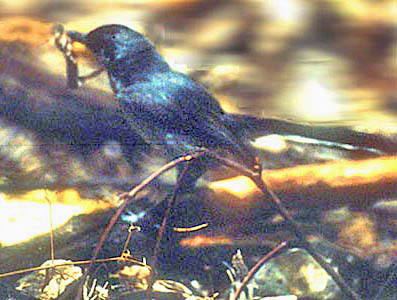
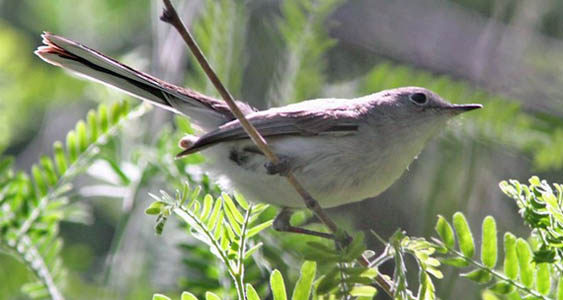
 With recent splits, more than half the gnatcatchers are South American species; the family evolved in South America (Smith et al. 2018). Masked Gnatcatcher (right) has a broad distribution south and east of the Amazon Basin, preferring a variety of dry forest types. It has little geographic overlap with other species of Polioptila.
With recent splits, more than half the gnatcatchers are South American species; the family evolved in South America (Smith et al. 2018). Masked Gnatcatcher (right) has a broad distribution south and east of the Amazon Basin, preferring a variety of dry forest types. It has little geographic overlap with other species of Polioptila.